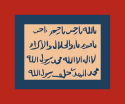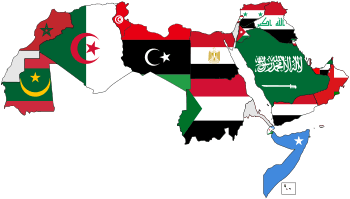Flag of Sudan
The current flag of Sudan (Arabic: علم السودان) was adopted on 20 May 1970 and consists of a horizontal red-white-black tricolour with a green triangle at the hoist. The flag is based on the Arab Liberation Flag shared by Palestine, Egypt, Iraq, Syria and Yemen that uses a subset of the Pan-Arab colours in which green is less significant. Prior to the 1969 military coup of Gaafar Nimeiry, a blue-yellow-green tricolour design was used.
 | |
| Use | National flag, civil and state ensign |
|---|---|
| Proportion | 1:2 |
| Adopted | 20 May 1970 |
| Design | A horizontal tricolour of red, white, and black; with a green triangle based at the hoist. |
Symbolism
According to World Flags 101:
Red, white, black and green are called the pan-Arab colours and have been historically linked to the Arab people and Islamic religion for centuries. The colours stand for Arab unity and independence. The red stripe represents Sudan's struggle for independence and many other struggles, and the sacrifices of the country's martyrs. The white represents the people, light and optimism. It also represents the White Flag League which was a nationalist group that rose up against colonial rule in 1924. The black represents Sudan; in Arabic 'Sudan' means black. It also represents the black flag of nationalists who fought colonial rule during the Mahdist Revolution, late in 19th century. Green represents Islam, agriculture and the prosperity of the land.[1]
Government and armed forces flags
Government flags
 Flag of the President of Sudan
Flag of the President of Sudan Customs ensign
Customs ensign
Armed forces flags
 Naval Ensign
Naval Ensign Air Force Ensign
Air Force Ensign
Historical flags
Mahdist Revolt
In 1881, at the beginning of the Mahdist War, the Mahdi Muhammad Ahmad appointed Abdallahi ibn Muhammad as one of his four caliphs (Khalifa) and handed him a black flag.[2] Abdallahi used his black flag to recruit Baggara Arabs and other tribes from the west. The other caliphs used differently coloured flags.[3] The black horizontal stripe in the current Sudanese flag is a reference to this Mahdist-era black flag.[4]
 Flag used during the Mahdist Revolt and in Mahdist Sudan (1881–1899).
Flag used during the Mahdist Revolt and in Mahdist Sudan (1881–1899). Banner used by the Mahdist Army; captured at Omdurman in 1898.
Banner used by the Mahdist Army; captured at Omdurman in 1898. The Black standard was also used in Mahdist Sudan
The Black standard was also used in Mahdist Sudan
Anglo-Egyptian Sudan
Between 1899 and 1956, Anglo-Egyptian Sudan was administered jointly as a condominium by Egypt and the United Kingdom. The condominium did not have its own flag; instead the flag of Egypt and the flag of the United Kingdom were always flown together, with the British flag taking precedence.[5]
A flag did exist as a rank flag for the British Governor General of the Sudan. In common with the rank flags of governors and commissioners of other British overseas territories, it consisted of a Union Flag defaced with a white disk bearing the territory's badge or coat of arms, surrounded by a wreath of laurel. As no badge or coat of arms existed for Anglo-Egyptian Sudan, the disk instead contained the words "GOVERNOR GENERAL OF THE SUDAN".
At the Afro–Asian Conference held between 18 and 24 April 1955, Sudan was represented by a white flag bearing the name "SUDAN" in red capital letters. [6][7][8]
.png) Flags used in Anglo-Egyptian Sudan (1914-1922)
Flags used in Anglo-Egyptian Sudan (1914-1922) Flags used in Anglo-Egyptian Sudan (1922–1956)
Flags used in Anglo-Egyptian Sudan (1922–1956) Flag of the British Governor General.
Flag of the British Governor General..svg.png) Flag of the Sudan Defence Force (1925-1956)
Flag of the Sudan Defence Force (1925-1956).svg.png) Provisional flag of Sudan used during the Afro-Asian Conference (April 1955).[9]
Provisional flag of Sudan used during the Afro-Asian Conference (April 1955).[9]
Republic of the Sudan (1956–1969)
Upon independence from Egypt and the United Kingdom on 1 January 1956, Sudan adopted a blue-yellow-green tricolour as its national flag. This flag was designed by the poet Macki Sufi [10] and remained in use until 1970, when the current flag was adopted.[11] The colours of the flag represented the River Nile (blue), the Sahara (yellow) and farmlands (green). They were chosen as they were neutral between ethnic groups and political parties.[12]
Use of this flag resurfaced during the 2018–19 Sudanese protests.[13][14][15][16][17]
.svg.png) Flag of the Republic of the Sudan (1956–1969)
Flag of the Republic of the Sudan (1956–1969).svg.png) Naval ensign (1956–1970).
Naval ensign (1956–1970)..svg.png) Customs ensign (1956-1970)
Customs ensign (1956-1970)
Democratic Republic of the Sudan (1969-1985)
Following a coup d'état in May 1969, the country was renamed the Democratic Republic of the Sudan and a competition was held to design a new flag. The winning entry was designed by artist Abdel Rahman Ahmed Al-Jali and was adopted as the national flag in May 1970. [10]
.svg.png) Flag of the Democratic Republic of the Sudan (1969–1970)
Flag of the Democratic Republic of the Sudan (1969–1970) Flag of the Democratic Republic of the Sudan (1970–1985)
Flag of the Democratic Republic of the Sudan (1970–1985).svg.png) Standard of the President of the Democratic Republic of the Sudan.
Standard of the President of the Democratic Republic of the Sudan.
Former provincial flags
References
- World Flags 101. "Sudan Flag - World Flags 101". WorldFlags101.com. Moxy Media. Retrieved 9 August 2008.
- Hill, Richard Leslie (1967) [First published 1951]. A Biographical Dictionary of the Sudan (2nd ed.). Routledge. p. 6. ISBN 978-0-7146-1037-5.
- Featherstone, Donald F. (1993). Khartoum 1885: General Gordon's Last Stand. Osprey military campaign series, v. 23. Osprey Publishing. p. 18. ISBN 978-1-85532-301-8.
- Fadlalla, Mohamed Hassan (2005). The Problem of Dar Fur. iUniverse. p. 33. ISBN 978-0-595-36502-9.
- "Sudan - Historical flags". Flagspot.net. Retrieved 26 June 2018.
- "Days of Struggle". tempo. 21 April 2015.
- https://eprints.bbk.ac.uk/4914/2/4914.pdf
- سودانية, ثقافة (1 July 2018). "Sudan's first flag, during the 1st conference of the Non-Alignment Movement in Bandung in 1955, Indonesia #SudaneseCulture #ثقافة_سودانيةpic.twitter.com/idxrMoTwnD".
- Isnaeni, Hendri F. "Sudan Belum Merdeka, Benderanya Sudah Berkibar di KAA". Historia - Majalah Sejarah Populer Pertama di Indonesia (in Indonesian). Retrieved 20 April 2020.
- "علم غير مألوف يرفعه السودانيون في التظاهرات.. ما قصته؟". عربي21. 28 December 2018.
- "Sudan - Historical flags". Flagspot.net. Retrieved 26 June 2018.
- "sudan rb". www.rbvex.it. Retrieved 13 June 2019.
- "Why is the First and Former Flag of Sudan Resurfacing on Social Media?". 500 Words Magazine. 27 December 2018. Retrieved 13 June 2019.
- Hashim, Mohanad (5 May 2019). "The art fuelling Sudan's revolution". Retrieved 13 June 2019 – via www.bbc.com.
- "Flying the flag for Sudan – what flag is that?". Radio Dabanga. Retrieved 13 June 2019.
- "Breakthrough agreement between Sudan protest leaders, military". Prothom Alo. Retrieved 13 June 2019.
- Amir Ahmed, Mohammed Tawfeeq and Tamara Qiblawi. "Sudan celebrates end of stand-off between military leaders and opposition". CNN. Retrieved 1 August 2019.

